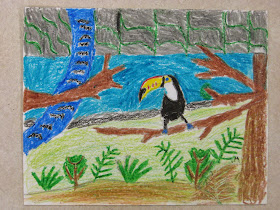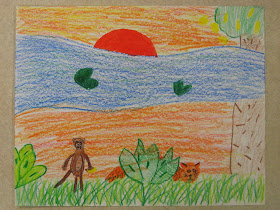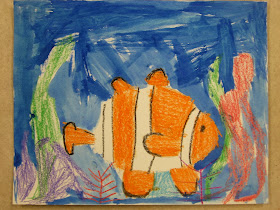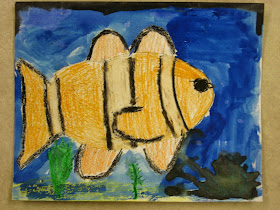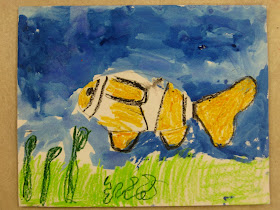My 5th grade students recently learned about Henri Rousseau, a mostly self-taught French artist. While in high school, Rousseau received art and music awards, but did not shine in other academic areas. He did not begin painting seriously until he was in his forties. His choice of subject matter for his paintings was the jungle, which is an interesting choice, as he never left France his whole life. Clearly, Rousseau used his imagination in creating his paintings, envisioning ways in which jungle animals would interact. He also must have looked at scientific drawings of the animals in order to draw them correctly.
My students used their imagination and photographs for reference to create their own jungle scenes. I really wanted to use oil pastels for this lesson, but unfortunately that is not an allowed medium by Art to Remember, a fundraiser our school does to raise money for art supplies. I am really hoping all my students will have at least two masterpieces completed by our deadline, Friday, so they can choose an artwork they really like for the program.
Here are some student-created Rousseau-inspired jungle drawings:
Monday, September 22, 2014
Tuesday, September 9, 2014
1st Grade Clown Fish Art
I recently introduced to my 1st grade students a French artist named Rosa Bonheur (1822-1899). As a child, Rosa had two sisters, and one brother. Her mother taught piano lessons, and her father was an artist. Rosa's father believed that little girls should be educated as well as little boys, so he gave all four of his children drawing lessons.
It turned out that Rosa was very good at drawing and painting. She was especially good at drawing animals. As she got older, she looked at real animals to create realistic pictures. She began to visit a veterinarian school so she could see the animals there, and draw them. At the veterinarian school, Rosa was very well-respected, and treated nicely because she was so good at drawing.
I showed the students several paintings by Rosa Bonheur. In each one, we noticed how the animal was painted very realistically, with attention to details, but also that each animals was in a realistic setting. We saw a painting of deer in the woods; of oxen plowing a field, and of sheep lying in the grass. The realistic settings Rosa painted her animals in made the pictures even more realistic!
Then, I told the students we were going to draw an animal just like real life, but not an animal Rosa Bonheur had ever drawn. In fact, she probably never saw this animal: a clown fish. I projected a clown fish on my Promethean board, and the students agreed with me that it would be very hard to draw. I traced the outline of the fish with my Promethean pen, and the students didn't think they could draw that tricky shape!
Well, real artists don't usually draw shapes that tricky either, I informed the students. Instead of drawing one hard shape, we drew six easy shapes and put them together. I guided the students through drawing an oval, adding fins and a tail, and finally details. Each fin got a black edge; we drew three white stripes, each edged in black as well. After adding an eye, we colored all the orange parts orange.
The following week, we talked about where we could find a clown fish. We needed to paint a realistic scene, just like Rosa Bonheur! In each class, often at least one student knew that clown fish are often found near sea anemone. So, we drew sea anemone, and some coral reef plants if the students wanted to, and then painted the water blue with watercolors.
Here are some finished results:
It turned out that Rosa was very good at drawing and painting. She was especially good at drawing animals. As she got older, she looked at real animals to create realistic pictures. She began to visit a veterinarian school so she could see the animals there, and draw them. At the veterinarian school, Rosa was very well-respected, and treated nicely because she was so good at drawing.
I showed the students several paintings by Rosa Bonheur. In each one, we noticed how the animal was painted very realistically, with attention to details, but also that each animals was in a realistic setting. We saw a painting of deer in the woods; of oxen plowing a field, and of sheep lying in the grass. The realistic settings Rosa painted her animals in made the pictures even more realistic!
Then, I told the students we were going to draw an animal just like real life, but not an animal Rosa Bonheur had ever drawn. In fact, she probably never saw this animal: a clown fish. I projected a clown fish on my Promethean board, and the students agreed with me that it would be very hard to draw. I traced the outline of the fish with my Promethean pen, and the students didn't think they could draw that tricky shape!
Well, real artists don't usually draw shapes that tricky either, I informed the students. Instead of drawing one hard shape, we drew six easy shapes and put them together. I guided the students through drawing an oval, adding fins and a tail, and finally details. Each fin got a black edge; we drew three white stripes, each edged in black as well. After adding an eye, we colored all the orange parts orange.
The following week, we talked about where we could find a clown fish. We needed to paint a realistic scene, just like Rosa Bonheur! In each class, often at least one student knew that clown fish are often found near sea anemone. So, we drew sea anemone, and some coral reef plants if the students wanted to, and then painted the water blue with watercolors.
Here are some finished results:
Saturday, September 6, 2014
6th Grade Russian Architecture Drawings
Well, my 4th year of teaching is well under way! Things are coming along so much easier this year. I finally know almost all of my students' names, since most of them have been with me for three years. We have a small kindergarten class this year (about 18 students per class; it's wonderful!).
Lesson planning is coming along so easily too; I have such a large stash of slide shows and art project examples stored away. Even though I often create new projects each year (to keep myself interested!), slide shows on famous artists can be very versatile, and some art assignments can be tweaked and taken in a new direction.
The pictures below are actually my last 6th grade assignment from last year; I just never got around to posting them! The students looked at many examples of Russian architecture. I had a slide show of about 10 Russian buildings in chronological order that we viewed. The common thread between all the buildings was, of course, the onion dome!
As the early buildings of the 1000's gave way to more ornate buildings, the students noticed more and more beautiful details. When we got to Saint Basil's Cathedral, the students could hardly believe it was real! I told them the legend that Ivan the Terrible had had the architect who designed it executed so that nothing more beautiful would ever be built. We all agreed that he was pretty terrible.
As my slide show went on, the students decided that Ivan the Terrible had gotten his wish; none of the buildings following Saint Basil's Cathedral were quite as beautiful.
Using oil pastels on black paper, the students created their own Russian architecture. They were all required to include some onion domes!
Halfway through this assignment, our school tech guy installed an Apple TV in my classroom (the PTO bought one for every teacher!), so I connected my iPad to my Promethean board, and we went to Google Earth and visited Moscow. I was able to move around Saint Basil's Cathedral, and view it from many different angles! It was really cool.
Lesson planning is coming along so easily too; I have such a large stash of slide shows and art project examples stored away. Even though I often create new projects each year (to keep myself interested!), slide shows on famous artists can be very versatile, and some art assignments can be tweaked and taken in a new direction.
The pictures below are actually my last 6th grade assignment from last year; I just never got around to posting them! The students looked at many examples of Russian architecture. I had a slide show of about 10 Russian buildings in chronological order that we viewed. The common thread between all the buildings was, of course, the onion dome!
As the early buildings of the 1000's gave way to more ornate buildings, the students noticed more and more beautiful details. When we got to Saint Basil's Cathedral, the students could hardly believe it was real! I told them the legend that Ivan the Terrible had had the architect who designed it executed so that nothing more beautiful would ever be built. We all agreed that he was pretty terrible.
As my slide show went on, the students decided that Ivan the Terrible had gotten his wish; none of the buildings following Saint Basil's Cathedral were quite as beautiful.
Using oil pastels on black paper, the students created their own Russian architecture. They were all required to include some onion domes!
Halfway through this assignment, our school tech guy installed an Apple TV in my classroom (the PTO bought one for every teacher!), so I connected my iPad to my Promethean board, and we went to Google Earth and visited Moscow. I was able to move around Saint Basil's Cathedral, and view it from many different angles! It was really cool.





